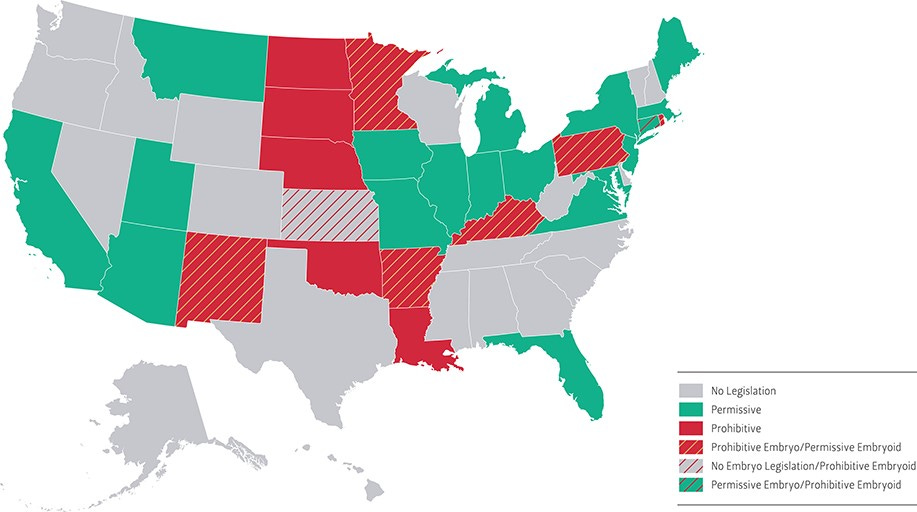Introduction
Embryo research is when scientists study the early stages of human development, usually within the first 14 days after an egg is fertilized. This research helps us understand how humans grow and can improve treatments like in vitro fertilization (IVF), where an egg is fertilized outside the body and then placed in a woman's uterus to grow into a baby.
For a long time, scientists agreed not to study embryos beyond 14 days because that's when a structure called the "primitive streak" forms, marking an important step in development. This 14-day limit was a compromise between allowing research and respecting ethical concerns about the moral status of embryos.
Recently, scientists have been able to grow embryos in the lab for longer than 14 days.
They've also created "embryoids," which are like simplified versions of embryos made from stem cells.
These embryoids can help researchers learn about early development without using actual embryos, but they also raise new ethical questions.
In 2021, a group of stem cell researchers decided to remove the 14-day limit from their guidelines, suggesting that research on embryos and embryoids should be considered on a case-by-case basis, depending on local laws and public support.
In the United States, there are no federal laws specifically about embryo or embryoid research, so each state can make its own rules. This has led to a patchwork of different laws across the country, with some states allowing this research and others banning or limiting it.
US Federal Laws and Guidelines
US government has some rules about this kind of research. There aren't any specific laws that cover both public and private research, but there are some guidelines that researchers need to follow. One of these guidelines is called the Dickey-Wicker Amendment (DWA), which is a rule that stops the government from giving money to research projects that create or destroy human embryos.
The National Institutes of Health (NIH) is a big organization that gives out money for medical research. They have to follow the DWA, so they can't give money to projects that work with human embryos. However, they can give money to projects that work with embryoids, but they decide this on a case-by-case basis.
There's also a rule that stops the Food and Drug Administration (FDA) from approving or even acknowledging any research that involves creating or modifying human embryos with genetic changes that can be passed down to future generations.
So, in summary, the US government has some rules about studying human embryos and embryoids. They don't give money to projects that create or destroy human embryos, but they might give money to projects that work with embryoids.
Researchers who want to study human embryos usually have to find private or state funding for their work.
Laws and Guidelines by State

In the United States, laws about embryoid research vary from state to state. Some states have no specific laws, while others either allow or ban this type of research. It's important to note that embryoids are not the same as human embryos, so some states may have different rules for each.
States without specific laws on embryoid research rely on federal guidelines. These states include Alabama, Alaska, Colorado, Delaware, Georgia, Hawaii, Idaho, Kansas, Mississippi, Nevada, New Hampshire, North Carolina, Oregon, South Carolina, Tennessee, Texas, Vermont, Washington, West Virginia, Wisconsin, and Wyoming.
Some states, like Arkansas, Kentucky, Louisiana, Minnesota, Nebraska, New Mexico, North Dakota, Oklahoma, Pennsylvania, Rhode Island, and South Dakota, have laws that ban most or all research involving human embryos. This can indirectly affect embryoid research, but not always.
On the other hand, some states have laws that allow and even support human embryo research. These states include California, Connecticut, Michigan, Montana, and New York. Other states, like Arizona, Florida, Illinois, Indiana, Iowa, Maine, Maryland, Massachusetts, Missouri, New Jersey, Ohio, Utah, and Virginia, also permit human embryo research, but with certain restrictions or conditions.
Reproductive Cloning
Reproductive cloning is a process that creates a copy of a living thing, like making a twin. Some people want to use this process to make babies, but many people think it's not a good idea.
In the United States, there is no national law that says you can't do reproductive cloning, but there are laws in 22 states that say you can't do it.
Some of these state laws also say you can't use a special process called Somatic Cell Nuclear Transfer (SCNT) for research. SCNT is a way to make an early-stage baby (called an embryo) by taking the inside of a body cell and putting it into an egg cell. This can help scientists learn more about how our bodies work and maybe find new ways to treat diseases.
There are 8 states that have very strict laws against reproductive cloning and SCNT. But there are also some states that say you can use SCNT for research, as long as you don't use it to make a baby. These states think it's important to learn more about our bodies and find new ways to help people who are sick.
In summary, reproductive cloning is a way to make a copy of a living thing, and it's not allowed in 22 states in the United States. Some states also have rules about using SCNT for research, but others think it's important to learn more about our bodies and find new ways to help people who are sick.
Conclusion
The laws and regulations surrounding human embryo and embryoid research in the United States are complex and vary from state to state. This can make it difficult for researchers to navigate the legal landscape and may also lead to inconsistencies in how research is conducted. It's important for scientists, policymakers, and the public to continue discussing these issues and work towards clearer guidelines that can help advance our understanding of human development while respecting different moral and ethical perspectives.





I’m not interested in the ethics regarding what I am proposing. My son died at 24 from a fentanyl overdose. He was embalmed and buried 4 years ago. Isn’t it possible that there is DNA that isn’t too degraded and could be used once the nucleus from the egg is removed, and put into a “blank” and implanted into a human? -Tanya